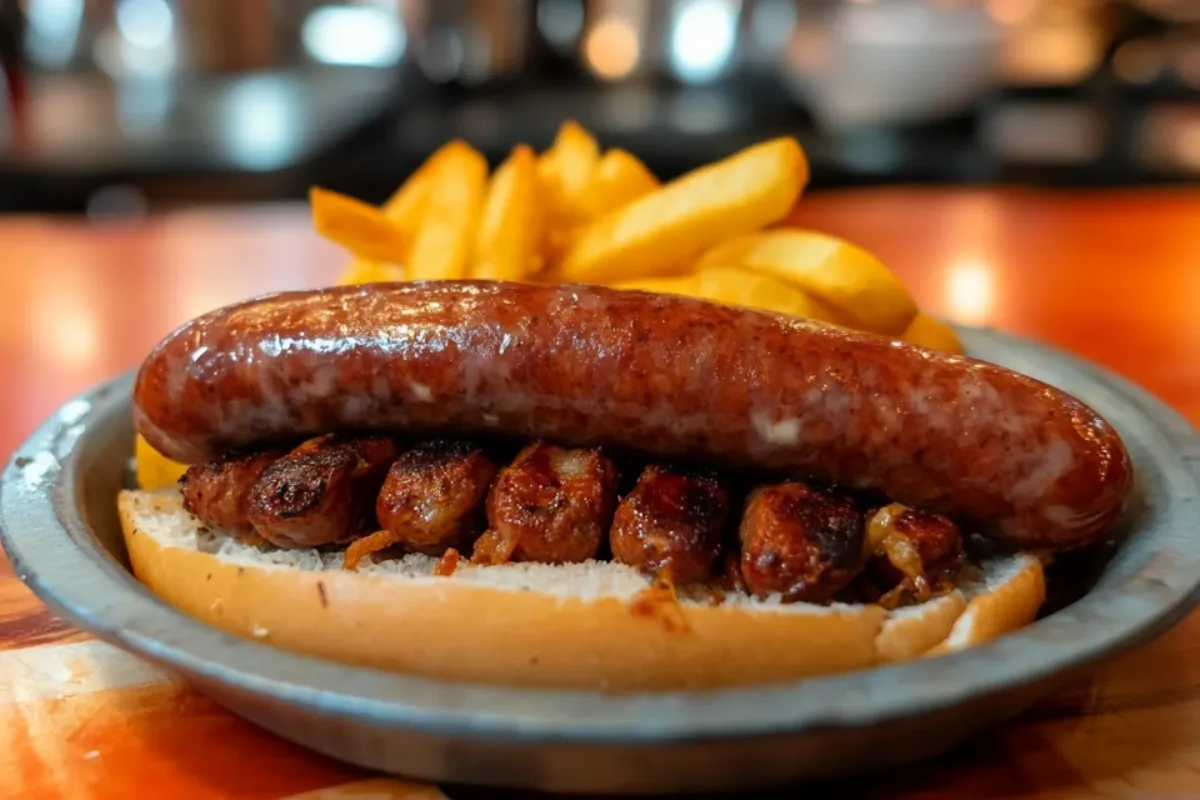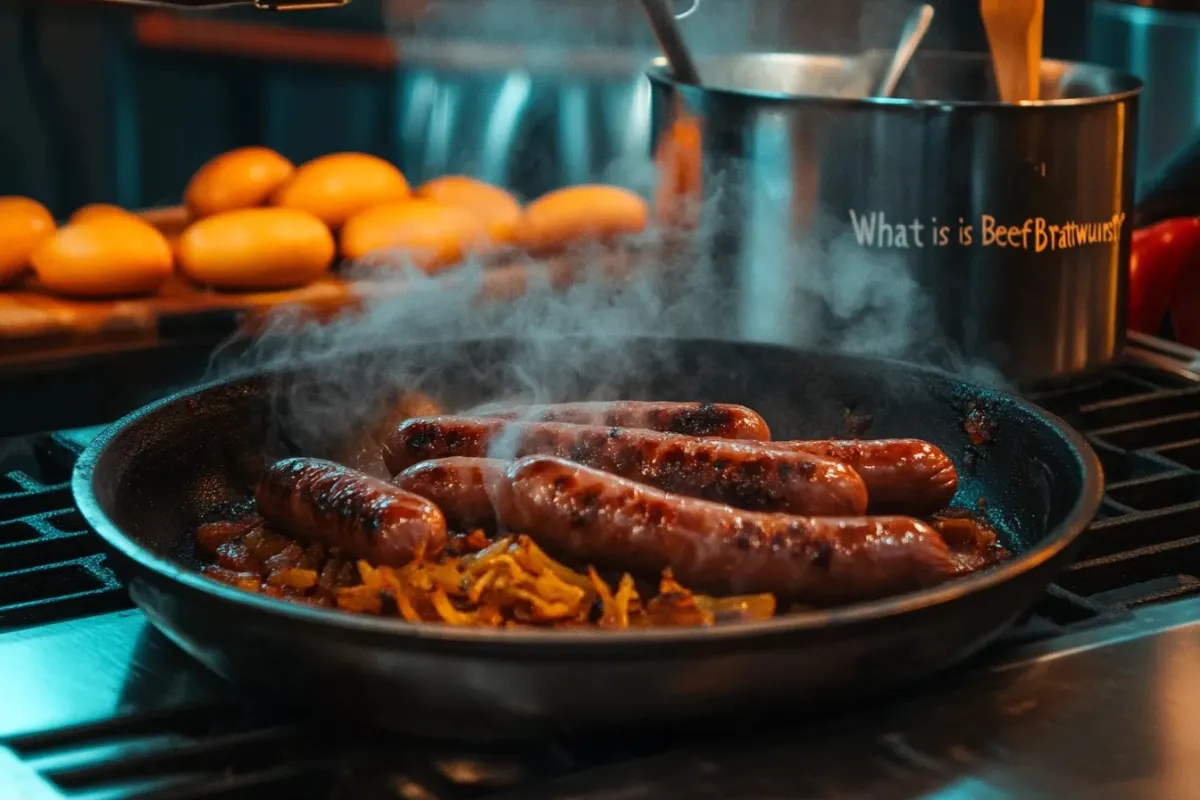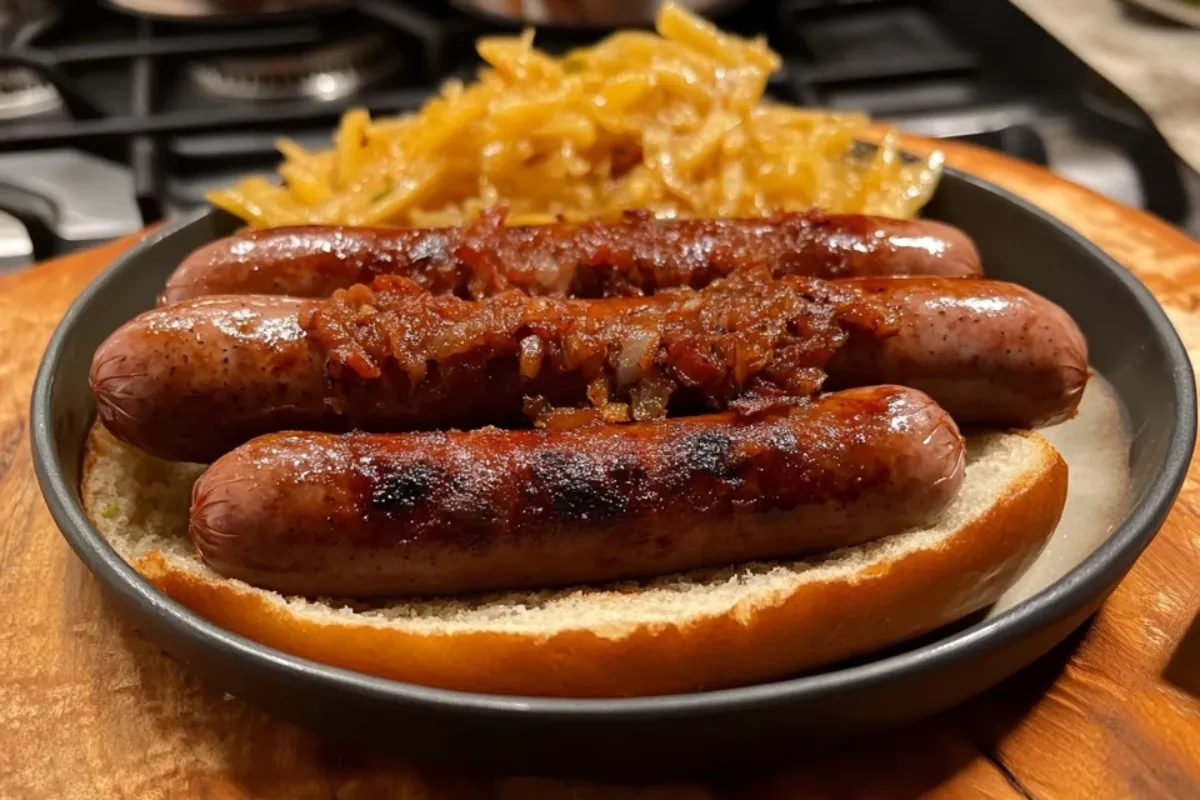Beef bratwurst is a German sausage loved by many, especially in America. It comes from Germany’s rich food traditions and has become a favorite ingredient in many dishes. Whether grilled, pan-fried, or simmered in broth, this sausage offers a delicious taste that people enjoy worldwide.
This guide will talk about the history, ingredients, cooking, and uses of beef bratwurst. You will learn about its German roots, how to cook it well, and creative ways to include it in meals. By the end, you’ll see why this sausage is loved by so many.
Key Takeaways
- Beef bratwurst is a German-style sausage with a long history.
- A mix of seasonings and good-quality beef gives it a unique flavor.
- You can grill, pan-fry, or braise it in beer for different tastes.
- Beef bratwurst is popular in American cooking and works with many dishes.
- Proper storage is important to keep it fresh and tasty.
What is Beef Bratwurst?
Beef bratwurst is a German-style sausage known for its rich flavor and firm texture. Unlike pork bratwurst, it uses ground beef, which gives it a unique taste and feel. It is flavored with spices like garlic, nutmeg, and caraway seeds, giving it a savory, slightly spicy flavor.
The sausage is plump and light-to-medium brown when cooked. While pork bratwurst is the classic version in Germany, beef bratwurst is gaining fans, especially in places where beef is more popular. Whether grilled, pan-fried, or braised in beer, beef bratwurst is a tasty choice for any meal.
The History and Origins of German Bratwurst
German Roots
The word “bratwurst” comes from the German words “brät” (finely chopped meat) and “wurst” (sausage). This tradition dates back to the 14th century in southern Germany. Butchers used pork, veal, or beef with spices and put the mixture in natural casings. Making bratwurst has always been about quality and care.
Changes in America
When German immigrants came to the U.S., they brought their food traditions with them. Bratwurst became a popular dish in American cuisine. Over time, beef bratwurst was created by using beef instead of pork to match local tastes. This brought new flavors and textures to the sausage.
Regional Types
In Germany, bratwurst recipes change depending on the region. For example:
- Nuremberger Bratwurst: Small sausages with marjoram.
- Thüringer Bratwurst: Known for its garlic and caraway flavors.
- Frankfurter Bratwurst: Larger and mildly seasoned.
Each type reflects the local culture and food traditions of its region.
Key Ingredients and Seasonings in Beef Bratwurst
Making great beef bratwurst starts with picking the right ingredients and seasonings. The main ingredient is high-quality beef, usually a mix of chuck and sirloin, which gives the sausage its rich flavor and firm texture. Spices add layers of flavor that make the sausage stand out.
| Ingredient | What It Does |
|---|---|
| Beef | Provides the main flavor and texture. |
| White Pepper | Adds mild heat and depth. |
| Nutmeg | Gives a warm, slightly sweet flavor. |
| Ginger | Adds a touch of spice and aroma. |
Other seasonings like marjoram, caraway seeds, and salt complete the flavor. Together, these ingredients create a sausage with a balanced and delicious taste.
Beef Bratwurst Production Methods :Traditional vs. Modern
Traditional Methods
Traditional bratwurst-making focuses on skill and care. Makers use fresh ingredients and family recipes passed down through generations. Sausages are stuffed by hand into natural casings and carefully seasoned, creating a product that celebrates German food traditions.
Modern Methods
Modern production uses advanced machines to meet high demand. These machines mix, grind, and stuff sausages quickly and consistently. Strict quality checks ensure food safety and make sure the sausage tastes good every time.
Both methods aim for high quality, but traditional methods often offer a more authentic taste experience.
Nutritional Profile and Health Considerations
Beef bratwurst is delicious but should be eaten in moderation. It’s high in protein but also has a lot of fat and sodium.
| Nutrient | Amount per 3.5 oz Serving |
| Calories | 290 |
| Protein | 20 g |
| Fat | 25 g |
| Sodium | 700 mg |
Despite its fat and sodium content, beef bratwurst provides important nutrients like iron and zinc, which are good for the immune system. Pair it with healthy sides to enjoy a balanced meal.
How to Cook Perfect Beef Bratwurst
Cooking bratwurst well makes all the difference. Each cooking method brings out a different flavor and texture.
Grilling
To grill bratwurst, heat the grill to medium-high. Oil the grates lightly to stop sticking. Place the sausages on the grill and turn them every few minutes to cook evenly. They’re ready when the inside temperature is 160°F (about 12-15 minutes).
Pan-Frying
For pan-frying, heat a skillet with some oil or butter on medium-high. Cook the bratwurst for 10-12 minutes, turning often, until browned all over and fully cooked.
Beer-Braising
Beer-braising adds a rich flavor. Place the sausages in a pot with your favorite beer. Simmer for 20-25 minutes, turning occasionally, until tender. Serve with the beer sauce for extra flavor.
Popular Serving Suggestions and Pairings
Beef bratwurst goes well with many dishes, from traditional German sides to creative modern recipes.
Traditional Pairings
- Sauerkraut
- Potato salad
- Warm pretzels
- Spaetzle (German egg noodles)
Modern Pairings
- Roasted vegetables
- Bratwurst-topped mac and cheese
- Bratwurst sliders on small buns
Pair these dishes with drinks like German beer, hard cider, or red wine. Try different combinations to find your favorite.
Storing and Preserving Your Beef Bratwurst
Refrigeration
Keep uncooked bratwurst in the fridge at 40°F (4°C) or lower. Wrap them well in plastic or use a container to keep them fresh for 3-5 days.
Freezing
To store for longer, freeze the sausages. Use freezer bags or wrap them in foil or plastic. They can last 2-3 months in the freezer.
Checking Freshness
Fresh bratwurst should feel firm and look bright. If they’re slimy, discolored, or smell bad, throw them out.
Frequently Asked Questions (FAQs)
What are beef brats made of?
Beef brats, short for beef bratwursts, use ground beef as their main ingredient. The beef is seasoned with spices and herbs like garlic, nutmeg, coriander, caraway seeds, and marjoram. After seasoning, the mixture goes into natural or synthetic casings, often collagen or animal intestines. Traditional bratwurst recipes use pork and veal, but beef brats focus only on beef as the protein source.
Some varieties of beef brats include:
- Binders or fillers like breadcrumbs or non-fat dry milk for texture.
- Preservatives like sodium nitrite for longer shelf life.
- Natural flavorings like onion or pepper.
Are beef brats the same as hot dogs?
No, beef brats differ from hot dogs, though they share similarities. Key differences include:
- Ingredients: Beef brats use coarsely ground beef with bold spices. Hot dogs use finely blended meat (beef, pork, or a mix) with simpler seasonings.
- Texture and Size: Beef brats have a chunky texture and are thicker. Hot dogs are smooth, uniform, and smaller.
- Flavor: Beef brats taste rich and hearty from their spices. Hot dogs are milder in flavor.
- Cooking Methods: People typically grill, fry, or braise beef brats in beer. Hot dogs are often boiled, steamed, or grilled.
What is the difference between sausage and bratwurst?
Bratwurst is a type of sausage, but not all sausages are bratwursts. Key differences include:
- Origin: Sausages exist worldwide and include many types. Bratwurst comes specifically from Germany.
- Ingredients: Sausages can use pork, beef, chicken, lamb, or combinations. Bratwursts traditionally use pork and veal, but beef brats focus on beef.
- Seasoning: Bratwursts feature German spices like marjoram, nutmeg, and caraway. Sausage seasonings vary widely by region (e.g., Italian sausages often include fennel and paprika).
- Cooking and Serving: People often grill or simmer bratwursts in beer and serve them with mustard or sauerkraut. Sausages may be smoked, cured, fried, or used in many dishes.
Do beef brats have pork?
Beef brats use beef for the filling, but some may include pork casings. Pork casings, made from intestines, are common even when the filling is all beef. In facilities processing multiple meats, small traces of pork might also occur. Check labels for certifications like “100% beef” or halal to avoid pork.
Conclusion
Beef bratwurst is a flavorful and versatile sausage with deep roots in German cooking. From its rich history to its many uses, it’s no wonder this sausage is loved worldwide. By learning how to cook it well and pair it with different dishes, you can enjoy beef bratwurst in endless ways. Try it out and enjoy every bite!


